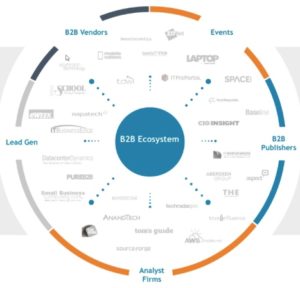If you haven’t heard of intent-based targeting, you’re already starting to fall behind the marketing curve. Intent targeting identifies accounts that are actively searching for specific topics across the internet. The vendors that sell intent-based marketing data, like Bombora, essentially have relationships with a bunch of different b2b news publishers, event publishers, analyst websites and lead generation websites. They use these relationships to aggregate all that data at an account level and can serve up the accounts that are “surging” across all of these networks on specific topics.
This is an example of Bombora’s partner network (from a year ago – I’m sure it’s gotten larger since that time):

Intent-based targeting is especially great for the B2B digital marketing professional that is looking for a new set of highly relevant accounts to go after. In fact, it is the perfect complement to account-based marketing and content marketing strategies.
To put this into a real-life scenario, imagine this:
- You’re a B2B marketer, and you’re trying to figure out which accounts are actively looking for the products or solutions you sell.
- You subscribe to an intent marketing vendor’s data feed.
- The vendor sends you a list of accounts that are actively searching for your product or solution on a weekly basis.
Sounds like utopia right? Well, that’s basically what this is. I say basically because the data is not 100% perfect. However, it’s a big step beyond your traditional look-alike predictive models that most of us used before intent-based targeting data.
So what can you do with this data? How can you activate it?
- Use account-based advertising tools (Think Terminus or DemandBase) to serve up highly relevant and targeted banner ads to these accounts.
- Create new levels of insight for your sales reps that are always looking for new data on their account targets. I’ve been able to activate this right inside of salesforce.com so my reps can see when the accounts they care about are in the market.
- Append contact data using any number of list vendors out there (I’ve been successful with discover.org), then add these contacts to drip email campaigns.
- Send the accounts and subsequent appended contact to your outbound BDR (business development reps) or external tele-vendors to begin prospecting with.
There are other applications of intent data. One compelling use case includes monitoring your existing customer base to identify when you potentially have a problem (i.e., they’re looking to move on).
Net, if you’re not already using intent-based targeting as part of your account-based marketing strategy, its time to step into this really fresh, and much-loved approach.
